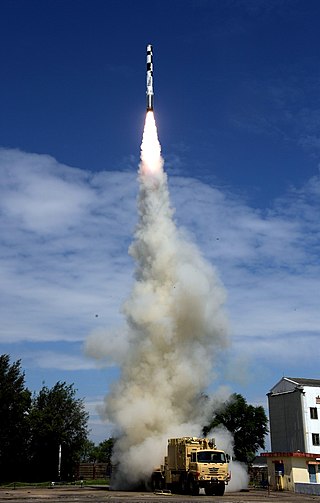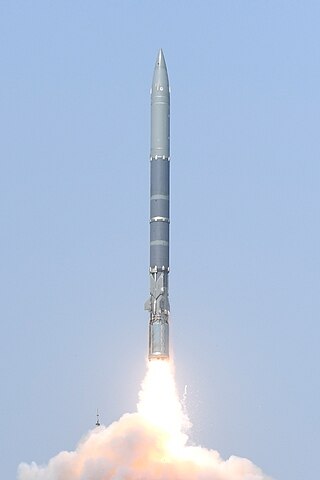
The Integrated Guided Missile Development Programme (IGMDP) was an Indian Ministry of Defence programme for the research and development of the comprehensive range of missiles. The programme was managed by the Defence Research and Development Organisation (DRDO) and Ordnance Factories Board in partnership with other Indian government political organisations. The project started in 1982–83 under the leadership of Abdul Kalam who oversaw its ending in 2008 after these strategic missiles were successfully developed.

Astra is an Indian family of all weather beyond-visual-range air-to-air missile, developed by the Defence Research and Development Organisation. Different missiles of this family are capable of engaging targets at varying distances of 500 m (0.31 mi) up to 340 km (210 mi). Astra Mk-1 has been integrated with Indian Air Force's Sukhoi Su-30MKI and will be integrated with Dassault Mirage 2000, HAL Tejas and Mikoyan MiG-29 in the future. Limited series production of Astra Mk-1 missiles began in 2017.

The BrahMos is a medium-range ramjet supersonic cruise missile that can be launched from submarines, ships, fighter aircraft or TEL. It is a joint venture between the Indian Defence Research and Development Organisation (DRDO) and the Russian Federation's NPO Mashinostroyeniya, who together have formed BrahMos Aerospace. The missile is based on P-800 Oniks. The name BrahMos is a portmanteau formed from the names of two rivers, the Brahmaputra of India and the Moskva of Russia.

The Sukhoi Su-30MKI is a two-seater, twinjet multirole air superiority fighter developed by Russian aircraft manufacturer Sukhoi and built under licence by India's Hindustan Aeronautics Limited (HAL) for the Indian Air Force (IAF). A variant of the Sukhoi Su-30, it is a heavy, all-weather, long-range fighter.

Nirbhay is a long range, all-weather, subsonic cruise missile designed and developed in India by the Aeronautical Development Establishment (ADE) which is under Defence Research and Development Organisation (DRDO). The missile can be launched from multiple platforms and is capable of carrying conventional and nuclear warheads. It is currently deployed in limited numbers in Line of Actual Control (LAC) during standoff with China.

The Indian Ballistic Missile Defence Programme is an initiative to develop and deploy a multi-layered ballistic missile defence system to protect India from ballistic missile attacks. It was launched in 2000 after the Kargil War by the Atal Bihari Vajpayee government. Testing was carried out and continuing as of 2006, and the system was expected to be operational within four years according to the head of the country's missiles development programme, Vijay Kumar Saraswat.

The Nag missile, also called "Prospina" for the land-attack version, is an Indian third-generation, all-weather, fire-and-forget, lock-on after launch, anti-tank guided missile (ATGM) with an operational range of 500 m to 20 km depending on variant. It has a single-shot hit probability of 90% and a ten-year, maintenance-free shelf life. The Nag has five variants under development: a land version, for a mast-mounted system; the helicopter-launched Nag (HELINA) also known as Dhruvastra; a "man-portable" version (MPATGM); an air-launched version which will replace the current imaging infra-red (IIR) to millimetric-wave (mmW) active radar homing seeker; and the Nag Missile Carrier (NAMICA) "tank buster", which is a modified BMP-2 infantry fighting vehicle (IFV) produced under license in India by Ordnance Factory Medak (OFMK).
The Indian Air Force has been undergoing a modernization program to replace and upgrade outdated equipment since the late 1990s to meet modern standards. For that reason, it has started procuring and developing aircraft, weapons, associated technologies, and infrastructures. Some of these programs date back to the late 1980s. The primary focus of current modernization and upgrades is to replace aircraft purchased from the Soviet Union that currently form the backbone of the air force.

Sudarshan is an Indian laser-guided bomb kit, developed by Aeronautical Development Establishment (ADE), a DRDO lab with technological support from another DRDO lab Instruments Research and Development Establishment (IRDE), for the Indian Air Force (IAF).
India has studied, produced and used various strategic and tactical missile systems since its independence. Decades long projects have realised development of all types of missile systems including ballistic, cruise, anti-ship, air-defence, air-to-air and anti-missile systems. India is one of seven countries in the world with intercontinental ballistic missiles (ICBMs) and one of four countries with anti-ballistic missile systems. Since 2016, India has been a member of Missile Technology Control Regime (MTCR).
Iron Fist is an Indian Air Force exercise held at Pokhran, Rajasthan. It has been held twice: 2013 and 2016.

The Rudram is a series of supersonic and hypersonic air-to-surface ground attack and anti-radiation missiles in development by the Defence Research and Development Organisation of India. It can be launched from a range of altitudes with large standoff distance for destroying enemy surveillance radars, communication stations and bunkers.
The DRDO Smart Anti-Airfield Weapon (SAAW) is a long-range precision-guided anti-airfield weapon developed by India's Defence Research and Development Organisation (DRDO). It is designed to be capable of engaging ground targets with high precision up to a range of 100 kilometres (62 mi).

The MPATGM or man portable anti-tank guided missile, is an Indian third generation fire-and-forget anti-tank guided missile (ATGM) derived from India's Nag ATGM. It is being developed by the Defence Research and Development Organization (DRDO)
The High Speed Low Drag (HSLD) bomb is a family of new generation short range air-dropped precision-guided munition that is currently being developed by India's Defence Research and Development Organisation (DRDO). This general-purpose bomb is made for the Indian Air Force (IAF) and can be used against the destruction of strategic high value enemy infrastructure from stand-off distances. HSLD is comparable to Mark 80 series of bombs used by United States Air Force (USAF).

Akash - New generation abbreviated as Akash-NG is a mid-ranged mobile surface-to-air missile defense system developed by the Defence Research and Development Organisation (DRDO) and produced by Bharat Dynamics Limited (BDL) and Bharat Electronics (BEL).

The Vertical Launch – Short Range Surface to Air Missile, or VL-SRSAM is a quick reaction surface-to-air missile developed by the Indian Defence Research and Development Organisation (DRDO).

SMART is a canister-based, long-range supersonic anti-submarine missile developed by the Defence Research and Development Organisation (DRDO) for the Indian Navy.
This article consists of projects of the Defence Research and Development Organisation.

The Very Short Range Air Defence System, or VSHORADS, is a fourth generation, man-portable air-defense system (MANPADS) developed by Research Centre Imarat (RCI),a research lab under Defence Research and Development Organisation (DRDO), located in Hyderabad. Multiple DRDO laboratories along with Indian Industry Partners are participating in the project. It is designed for anti-aircraft warfare and neutralising low altitude aerial threats at short ranges.















